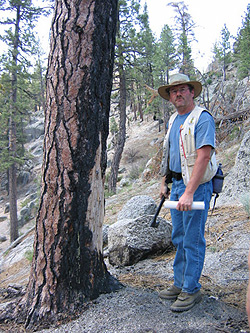Berkeleyan
Mexican woods offer a look at California forests' past
U.S. forests, managed for 'average conditions,' resemble nothing so much as 'a carpet of trees.' Such homogeneity encourages fire, disease, and insects, says a Berkeley researcher
![]()
| 25 August 2005
 On an expedition to the Sierra de San Pedro Mártir in Baja California, Scott Stephens, a professor of fire science, illustrates how fire kills part of the cambium, the living tissue beneath the bark of a tree. Using a simple hand axe, Stephens exposes the edge of the killed cambium so its extent can be measured. (Kurt Menning photo) |
Stephens, a faculty member in environmental science, policy, and management, organizes twice-yearly research expeditions to the unspoiled Sierra de San Pedro Mártir, a mountainous region in Baja California named after the Christian martyr St. Peter. He regards the mixed-conifer forests there as a living example of what many California forests would be without the exploitive logging practices of earlier generations, fragmentation by development, and disruption of natural fire cycles. And what he's learned from seven years of studying that ecosystem has convinced him that forest-management plans in California should be revised to improve the forests' resilience to insects, diseases, drought, and catastrophic fires.
The San Pedro Mártir, connected to the Laguna and San Jacinto ranges of southwest California, is home to flora and fauna similar to those found in the forests of Southern California and the eastern Sierra Nevada. "When you're there, with all the familiar shrubs and soils and trees, sometimes you have to remind yourself you're in Mexico," Stephens says.
But differences between the regions do exist — for example, in the approach taken to managing the seasonal forest fires to which both ranges are subject. Whereas most California fires are managed aggressively, with armies of firefighters employing sophisticated equipment, helicopters, and air tankers, until 1970 there was no fire suppression at all in the Sierra de San Pedro Mártir, much of whose 100,000-acre forest has never been harvested and has survived through centuries of natural fire cycles.
The vacation homes, campgrounds, lodges, shopping centers, and other developed landscapes that have permanently altered the makeup of California's forests are also not to be found in Mexico's sparsely populated Mártir. This intrusion of humans and their built environment into the forest has done much to guide the interventionist fire-management policies of forest managers on this side of the border.
Historical timber-harvesting practices have also altered the natural forest ecosystem. Says Stephens: "The logging that took place before early Californians understood sustainable timber-harvest practices created huge disturbances in the forest ecosystems that still affect those forests today."
As a result of all these factors, the differences between the never-touched and frequently burned Mexican forests and California's fire-suppressed and highly developed forests are visible on several levels. For example, in the early 2000s, following a few years of drought, the Southern California mountain landscape was dominated by dead trees, which had succumbed to attacks by native bark beetles. The Mexican mountains experienced the same drought, but many more trees were able to survive the bark-beetle onslaught. In addition, a large wildfire burned about 10,000 acres of the Mártir in July 2003.
"Even though the trees were incredibly stressed by drought and the fire, less than four percent of the overstory trees are dying," says Stephens. "At the end of the drought in California, many more trees were dead, and this occurred without wildfire. Mártir has a resiliency that we don't see anywhere in California."
Stephens attributes this resiliency to the Mexican forest's diversity. "In 85 percent of the area, there is tremendous variation in the forest makeup," he says. And indeed, relatively frequent, lower-intensity fires in the Mártir lead to variable and patchy forests. When insects or pathogens later encounter patches and spaces, they have trouble establishing a foothold; hence, the forests have a greater ability to survive.
"But what we're doing in the United States is actively managing forests for average conditions," observes Stephens. "And what we're getting is a giant carpet of trees. When all the forest areas are the same, fires, disease, and insects can more easily move through entire stands."
Based on his research in Mexico, Stephens says, he believes the forest-management approach taken in the United States must be changed. Greater forest structural diversity can be achieved, he suggests, by giving more latitude to "on the ground" forest managers, allowing them to be creative rather than obliging them to adhere strictly to per-acre management plans. "They can go in and try some things to break up the homogeneity," Stephens says.
Stephens' next trip to the forests of Sierra de San Pedro Mártir is scheduled for October. His forest studies are funded in large part by the UC Agricultural Experiment Station, an organization of researchers on UC's Riverside, Davis, and Berkeley campuses affiliated with the UC Division of Agriculture and Natural Resources.

